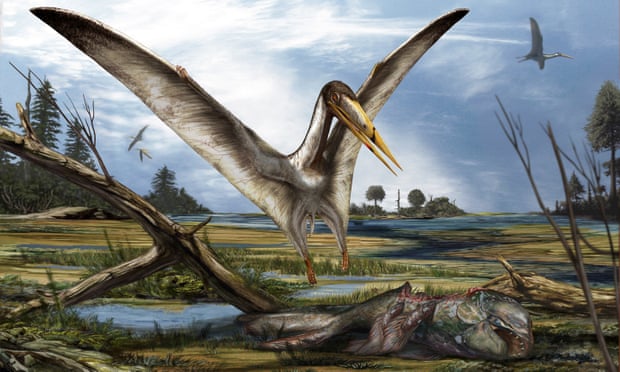
A fossil in a Brighton museum that was initially thought to be a shark fin skeleton - has been wrongly labelled - and has now been identified as a completely new species of prehistoric flying reptile.
The Guardian reports that the fossil had been languishing in a draw Booth museum before the remarkable realisation was made.
Roy Smith, a University of Portsmouth PhD student, identified the creature after realising it was much more unusual and interesting than its label suggested.
He identified the fossil as the tip of the beak of a new species of pterosaur (from the Greek for “winged lizard”), a creature that existed 228m-66m years ago and the earliest vertebrate known to have evolved powered flight.
The report says the pterosaur would have resembled the alanqa, pictured above, which also has a broad wingspan and sharp beak.
The article says a Pterosaurs with this type of beak have been found in north Africa, so Smith and others who have studied the find say it is reasonable to assume a likeness to the alanqa, a frightening-looking creature thought to have a wingspan of 4 metres or more.
Smith discovered the creature during a trawl of fossil collections housed in the Booth Museum in Brighton.
The fossils were originally unearthed by workmen digging for phosphates in the Fens in the 19th century, who sold them on for a little extra cash.
It was while Smith was examining the fossils of what were labelled as shark fin spines that he realised some of them were actually fragments of the jaws or beaks of pterosaurs. The do resemble shark fin spines but with crucial differences.
Smith said:
“One such feature are tiny little holes where nerves come to the surface and are used for sensitive feeding by the pterosaurs. Shark fin spines do not have these but the early palaeontologists clearly missed these features.
“Two of the specimens discovered can be identified as a pterosaur called ornithostoma, but one additional specimen is clearly distinct and represents a new species. It is a palaeontological mystery.”
You can read the full report in the Guardian here.

 Teenager In Custody On Crawley Attempted Murder Charge
Teenager In Custody On Crawley Attempted Murder Charge
 Appeal Following Assault In Hastings
Appeal Following Assault In Hastings
 Road Closed As Armed Police Attend Incident In Worthing
Road Closed As Armed Police Attend Incident In Worthing
 Lewes District Council Placed In Planning Special Measures
Lewes District Council Placed In Planning Special Measures
 ‘Life-Changing’ Medication For Asthma Patients Now Available In Sussex
‘Life-Changing’ Medication For Asthma Patients Now Available In Sussex
 Arms Factory Demonstrator Disrupts Brighton & Hove Council Meeting
Arms Factory Demonstrator Disrupts Brighton & Hove Council Meeting
 Patients Forced Into 'Pharmacy Bingo' - As Survey Says Medicine Shortages 'Beyond Critical'
Patients Forced Into 'Pharmacy Bingo' - As Survey Says Medicine Shortages 'Beyond Critical'
 Appeal for information After Man Dies In Hastings Collision
Appeal for information After Man Dies In Hastings Collision
 Wealden To Hold National Dementia Action Week This Month
Wealden To Hold National Dementia Action Week This Month
 Brighton Food Festival To Be Charged For Mud Bath
Brighton Food Festival To Be Charged For Mud Bath
Comments
Add a comment